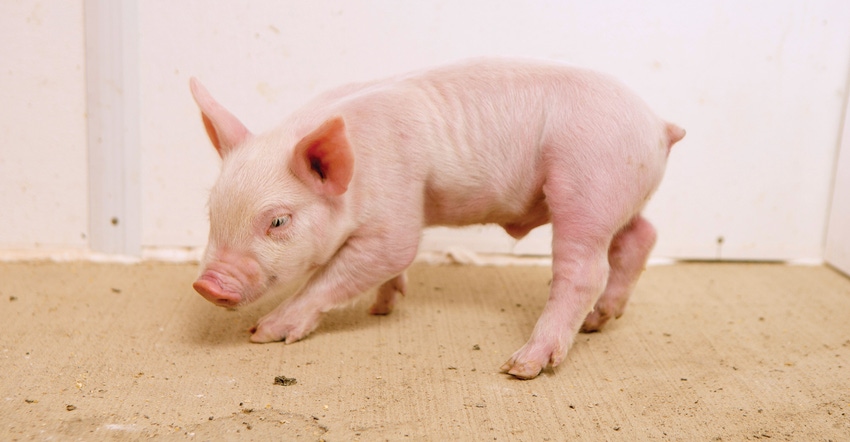Sleuthing piglet tremors
Atypical porcine pestivirus genome detected in newborn piglets.
January 3, 2020

Pig farmers can do everything the right way, and still have their herd succumb to some production or life-threatening virus or bacteria. Such problems started to arise at a research farm with high-health status and a comprehensive vaccination program, and that was naïve for other important pathogens. Cases of congenital tremor were starting to be observed in August 2017.
Blood samples were collected from newborn piglets from normal litters as well as from litters affected by congenital tremor and housed in the same facility.
Following initial cases of congenital tremor, a controlled exposure dataset was generated (in March 2018) by subjecting maternal crossbred gilts (n = 91) to an inoculate obtained from fetal fluids and membranes collected from sows that produced litters affected by congenital tremor.
Litter size traits, including total number of piglets born, number of mummified and stillborn, and presence of splayed legs were recorded at farrowing. The weight of the piglets was measured at birth and at weaning (see table below).

Postmortem histological examination identified a small number of scattered white-matter vacuoles in the cerebellum and underlying brainstem of affected piglets. Presence of potential viral sources associated with this neurologic condition was initially infirmed using quantitative polymerase chain reaction for atypical porcine pestivirus (APPV), porcine teschovirus and porcine sapelovirus.
Through metagenomic analysis, APPV was identified as the main microbial species in serum obtained from piglets affected by congenital tremor. These piglets had higher preweaning mortality rates (46.4% vs. 15.3%) and incidence of splayed legs (33.0% vs. 0.8 %) compared to unaffected piglets. Piglets affected by congenital tremor had higher viral titer and larger birth weights compared to normal littermates.
A significant relationship was observed between the frequency of congenital tremor and splayed legs. Incidence of splayed legs was observed in the majority of the litters affected by congenital tremor (73.2%), while in the unaffected litters, the incidence was limited (6.0%). The presence of splayed legs in piglets affected by tremor (33.0 %) was larger compared to unaffected piglets (0.8 %) (see table above). The average frequency of splayed legs in the litters affected by congenital tremor was 22.4%, while in the unaffected litters, the average frequency was marginal (0.5%).
To assess the evolutionary relationship of the novel strain with the other APPV strains, the DNA sequence and the viral polyprotein sequence were compared with that of 30 other complete APPV genome and protein sequences, respectively. Genomic data was retrieved from GenBank.
A significant relationship between the occurrence of congenital tremor and birth weight was observed across and within litters. Piglets from litters not affected by tremor had greater birth weight (1.30 ± 0.02 kg) compared to piglets exhibiting tremor (1.22 ± 0.02 kg) and their unaffected littermates (1.09 ± 0.03 kg) from affected litters.
Interestingly, piglets exhibiting congenital tremor had larger birth weights compared to their normal littermates.
Sequencing of the novel APPV strain was based on full-genome preamplification using a web-based tool for primer design. The primers were designed based on the initial nanopore sequencing of the MK728876 strain and its genetically closest complete genome sequence of a porcine atypical pestivirus 1 (MF167291.1).
Estimates of the number of APPV copies or viremia in serum was performed using cDNA based on isolated viral RNA and reverse-transcribed. Viral RNA was extracted from blood collected at an average age of 6.6 ± 0.3 days from all available piglets from 25 litters (out of 91 total) affected by congenital tremor (n = 171). The APPV presence was determined based on a qPCR specific to the novel APPV MK728876 strain.
The newly designed qPCR assay provided the required specificity for the diagnostic of the new APPV strain. Specifically, all the piglets exhibiting congenital tremor, as well as their littermates, were positive for APPV; the litters not affected were negative. Profiled at the same time with piglets, all the dams were qPCR-negative. The majority of the pigs (69.6%) were still positive for APPV at about 30 days of age.
The clear signs of tremor disappeared in the vast majority of pigs at 50 days of age (91.6%), and a suggestive decrease in viremia was observed at this point. Initial nanopore sequencing data also suggested the lack of specificity of the reported APPV qPCR assay was the most likely reason for the early negative-APPV diagnostic analysis.
Specifically, the forward primer of the reported qPCR assay includes three nucleotide mismatches, compared to the sequences obtained from the newly identified strain.
Genome sequencing difficult
Generating whole-genome sequencing data and complete genome assembly directly from clinical samples is challenging due to relatively low viral titer. In this study, a whole-genome preamplification approach was used successfully for generating complete genome sequence of the Zika and other viral genomes directly from clinical samples.
Complete genome sequences available in the National Center for Biotechnology Information nucleotide and protein databases consisting of 30 APPV strains isolated across the globe were subjected to phylogenetic analysis using the sequences of the viral genome and the viral polyprotein. Both analyses revealed two noticeably divergent clades: the large one contained 24 strains, from different geographical locations, while the smaller clade included seven strains so far reported only in China.
The relationship between the presence or absence of congenital tremor and occurrence of stillborn, mummies and splayed legs across litters was evaluated by a Pearson Chi-Square contingency test, coding the presence or absence of the targeted phenotypes in each litter.
A linear mixed model was used to investigate the association between presence or absence of congenital tremor and birth weight, weaning weight and average daily gain during lactation. The model included litter as random effect, litter size as covariate, and sex and occurrence of congenital tremor as fixed effects.
A linear mixed model was used to investigate the relationship between APPV viral titer and presence or absence of congenital tremor. The model included birth weight as a covariate, presence or absence of tremor as fixed, and litter as random effects.
Future research needs to address potential underdiagnosis due to genetic diversity, but it also needs to discover the mode of transmission, variation in virulence, and the role of host genetics in APPV susceptibility. Sequence variation of APPV strains even within the United States alone could lead to underdiagnosis of pestivirus-associated congenital tremors.
A paper describing in detail these results was recently published in the Journal of Animal Science.
Researchers: Kylee M. Sutton, University of Nebraska-Lincoln Animal Science Department; Kevin K. Lahmers, Virginia-Maryland College of Veterinary Medicine Department of Biomedical Sciences and Pathology, and Virginia Tech Animal Laboratory Services; Seth P. Harris, UNL Veterinary Diagnostic Center, School of Veterinary Medicine and Biomedical Sciences; Hiruni R. Wijesena, UNL Animal Science Department; Benny E. Mote, UNL Animal Science Department; Stephen D. Kachman, UNL Department of Statistics; Tudor Borza, Dalhousie University Department of Plant, Food and Environmental Sciences; and Daniel C. Ciobanu, UNL Animal Science Department and School of Biological Sciences. For more information, contact Ciobanu.
You May Also Like


